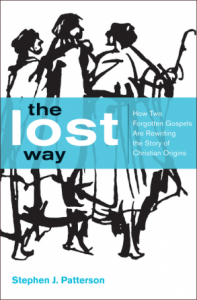 This past month I had the pleasure of reading several good books, including
This past month I had the pleasure of reading several good books, including
- (5) The Lost Way: How Two Forgotten Gospels Are Rewriting the Story of Christian Origins by Stephen J. Patterson (2014)
- (4.5) City of God: Faith in the Streets by Sara Miles (2014)
- (4.5) Forward Together: A Moral Message for the Nation by William J. Barber II (2014)
- (4) Kingdom Conspiracy: Returning to the Radical Mission of the Local Church by Scot McKnight (2014)
- (4) Pastors Sound Off: Causes We Can’t Keep Quiet About – 11 short essays by 11 authors (2014)
- (4) Eight Preachers Go to Hell: Reflections on the Place No One Wants to Go – 8 short essays by 8 authors (2014)
- (2.5) The Answer to Bad Religion is Not No Religion: A Guide to Good Religion for Seekers, Skeptics and Believers by Martin Thielen (2014)
So What?
Contemporary followers of Jesus often seek to follow the Way of Jesus as best they can. Toward this end, any effort designed to increase understanding of who Jesus really was and what he taught is welcomed. Patterson – a leading New Testament scholar and the former head of the Jesus Seminar’s project on Christian Origins – moves in that direction by challenging common assumptions of who Jesus is inasmuch as they are based primarily or solely upon the canonical Gospels. Rather than engage in a deconstruction of that perspective alone, he uses The Lost Way as a vehicle to advance an alternative view based on earlier texts.
As a college freshman I was introduced to a problem I had never considered: How did Matthew and Luke manage to tell the story of Jesus in such a similar fashion without writing together? Some of the answer is, of course, sharing a similar source we now call the Gospel of Mark. The rest of the answer requires the sharing of a second source, which most refer to as Q (short for Quelle, a German word meaning source). While Q has long been postulated, it remains hypothetical since no actual copies of it have been found.
Patterson begins by explaining what Q is, how it came to be, and what it contains. Relying on his earlier experience as one of more than two dozen scholars who reconstructed a version of Q in Greek, he offers an English language translation of such to allow readers to move beyond reading about Q to actually reading it.
He then considers a second early text: the Gospel of Thomas. Unlike Q, this text actually exists but there is no consensus for its date. Patterson considers what is found in Gospel of Thomas and why such matters before presenting the actual text. In this case the text is his translation of the 114 sayings of Jesus, which comprise the text.
Given what is found in these two earlier sources, Patterson begins the constructive task of determining who Jesus was and what he taught. 53 of Jesus’ sayings are found in these two texts and 26 appear in both Q and Thomas as “straightforward proverbs, aphorisms, parables or sayings of social critique” (p.195). Jesus is a wisdom teacher focused on the here and now. He was a sage and a prophet. “In Q and the Gospel of Thomas we recover something of that original modality of Jesus – wisdom. This is the lost Way” (p. 254).
Whether or not you find Patterson’s argument compelling, it is worth considering. The Lost Way invites conversation and is, therefore, well suited for a small group or adult study that is highly participatory in nature.
- Is your view of Jesus shaped primarily by the New Testament, church tradition, theology, your denomination or some other source?
- What additional sources have informed your perspective?
- Do you think Jesus was focused more on this life or the next? Why?